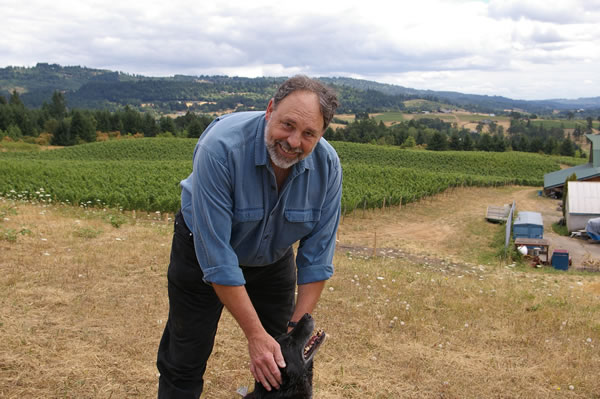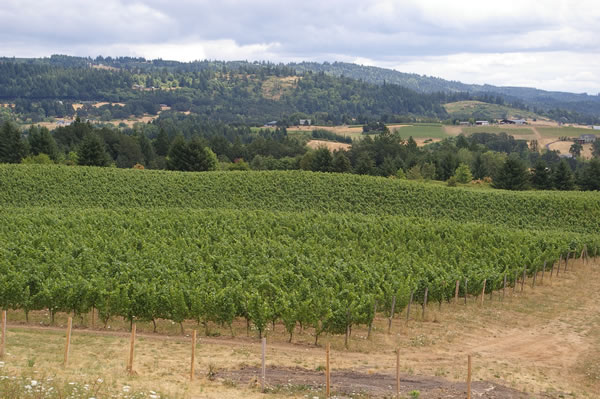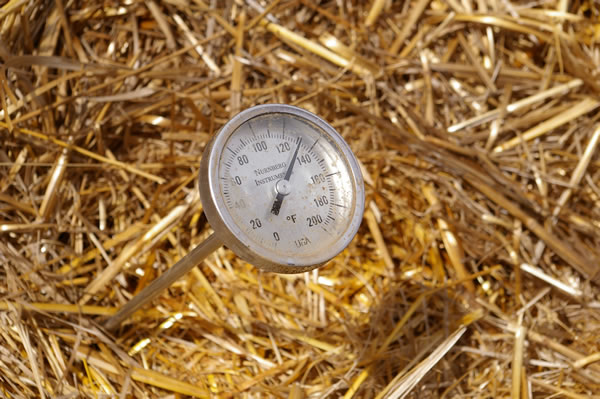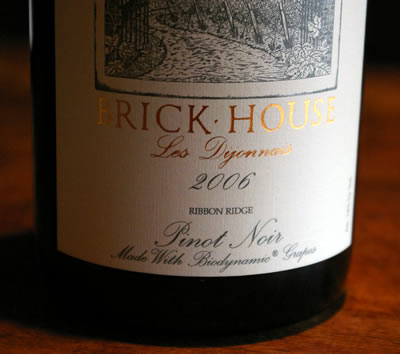|
Oregon
wine country, part 4
Brick
House

With its gently rolling hills, Oregon wine country is
beautiful, and it’s hard not to be just a little bit envious of
Doug and Melissa Tunnel’s Brick House estate.
As it is for so many, winegrowing is a second career
for Doug (pictured above). He established Brick House in 1990
after working as a news guy for CBS. His first plantings were 10
acres of Pinot Noir on its own roots, and this was followed in 1992
with some Chardonnay. While he was working in France, Doug developed
an affection for Gamay, and so – unusually for Oregon – he now
has 3.5 acres of Gamay Noir (the true Gamay).
Brick House is in a new sub-appellation of the
Willamette Valley called Ribbon Ridge AVA. This is part of the
Chehalem Mountains, another appellation that Doug could use. From
here you can see the Dundee Hills to the south. Doug’s neighbours
include Adelsheim and Bergstrom.

For CBS, Doug worked as foreign correspondent, with
postings in Lebanon, London, Bonn, Paris and Miami. ‘In the course
of living in the middle east and Europe I came to love wine’, he
recalls. ‘In 1988 I was living in Paris and spent all my vacation
time in a vineyard’. The Doug heard that the Drouhin family were
buying 120 acres in Yamhill County. He’d grown up in Oregon, about
five miles from where he’s now living, so he put the word out to
his family that he’d be interested in buying an old farm in the
area.
In 1989 an old friend of the family alerted him to a
property and Doug bought it the same day. The transition from
journalism to farming turned out to be an easy one. ‘I bought my
first tractor and loved driving it’, says Doug. ‘It was a great
release and very soothing after my previous life’. He’d lived
for 7 years in Beirut during the war, so he was ready for the
peaceful life. ‘It’s not for everyone’, he admits. ‘A lot of
people would go nuts out here, but Melissa and I really enjoy it’.
Initially Doug just wanted to grow organic wine grapes,
and he sold the fruit to three or four really good wineries. But
this wasn’t profitable, so he realized he had to make wine himself
to make a living. Doug is self-taught as a winemaker, although
initially he had help from Steve Doerner of Christom.

Right from the beginning, in May 1990, he wanted to do
this without any synthetic chemicals, certifying organic right away.
In 2001, however, he started to take an interest in biodynamics in
order to get away from the need to use copper (which is permitted as
a fungicide in both organics and biodynamics). He chatted with his
organic certifier, who put him in touch with a friend who did
Demeter certification, and Doug and Mike Etzel (Beaux Freres) had
this guy over for lunch.
The first practical move towards organics was to build a compost
pile. A group of around 10 winegrowers took a class together in
2002. Doug slowly began building his piles and started using
preparations. He began working with his Chardonnay, and then
expanded biodynamics to his Dijon block of Pinot Noir. It seemed to
be working, and since 2005 Brick House has been Demeter certified
biodynamic.
‘I believe in certification’, says Doug. ‘It is
good for people to step up if they are making the claim and take
responsibility to prove it.’ He adds that, ‘the story is not
over: I am still a student; I am still reading and studying. I feel
a lot of times I am not doing enough’. It does seem to be having a
significant effect. ‘I wouldn’t do it except that I’m
beginning to see real results. If I look at the wines from 2002 and
2003, five years later I am really pleased with them. I can’t make
the claim that it’s because of biodynamics, but I am motivated’.

We take a look around the vineyards. Doug has a special
machine for tilling called a spader (above), which comes from
Italy. Many people use rotor tillers with blades that take out
weeds, but over time these can result in a till pan, and water
doesn’t percolate through this. The rotor tillers also pulverise
the soil, and because the soil at Brick House is sedimentary, it is
prone to turning into sand. The spader has paddles that poke and
move the ground, leaving no pan so that water can percolate.

His compost heaps are impressive. He uses a 3:1 mixture
of manure from an organic dairy and the residue from fermentation
(seeds, stems), covered by organic straw.
In the winery Doug uses indigenous yeasts and allows a
natural malolactic fermentation. He rarely pumps the wine unless he
has to. He acidifies where necessary, although this is not needed
for Gamay. He rarely has to add sugar.
Recent vintages? 2006 was a good warm year. 2007 was
more problematic because of a rain event: there was a storm on 28th
September and it rained for five days. The whole of western Oregon
had this; it’s not all that unusual in Oregon to get harvest rain,
but this came after three years of lovely dry harvest weather.
Brick House Cascadia Chardonnay 2006
This is a 1 acre own-rooted block, Dijon clone, where the
biodynamic experiment started. Very pure, fresh, toasty, slightly
nutty nose with a strongly mineral edge. The palate has lovely
fullness and purity with good acidity, as well as a smooth texture.
Really nice freshness. 92/100
Barrel samples
-
2007 Chardonnay from 500 litre new oak barrel: pure and
fresh with good acidity
-
2007 Gamay Noir: (1)
lovely supple bright, pure cherryish fruit; (2) very fresh
cherryish fruit with good acidity.
-
2007 Pinot Noir: (1) before the rain – very fresh,
light and sappy, quite elegant; (2) 114 and 115 clones in new
oak, picked same day – chocolatey, spicy edge to the bright
fruit, fresh and high acidity; (3) Dijon 114 picked first
morning after rain (4 October) – light colour, supple, fresh
and spicy with nice expression, bright and a bit dilute; (4)
same day, new barrel – some structure, fresh, pure, elegant
with oak adding structure; (5) 5 October, Pommard block –
quite structured with some density. Nicely spicy; (6) Boulder
Block, Pommard clone – very expressive with new oak working
really well, a lovely wine; (7) 7 October 115 clone
‘Triangle’ block – super-elegant, fresh and pure with
lovely red fruits.
 Brick
House Boulder Block Pinot Noir 2006 Brick
House Boulder Block Pinot Noir 2006
All Pommard clone. Rich, spicy red fruit character on the nose.
Sweetly fruited but with some elegance and definition. A rich style
with some spicy structure. Satisfying and quite big. ($42 retail)
90/100
Brick House Les Dijonnais Pinot Noir 2006
Smooth, elegant and pure with focused red fruits nose and lovely
purity. The palate shows nice texture and good tannic structure.
Really lovely elegance here: a brilliant wine. ($49 retail) 94/100
Brick House Evelynis Pinot Noir 2006
Fresh, bright, vibrant cherry fruit nose is highly aromatic. The
palate is quite dense with some nice structure. Dense but still
quite pure with focused, fresh fruit and some spicy oak. ($59
retail) 92/100
See also:
Wines tasted 07/08
Find these wines with wine-searcher.com
Back
to top
|

